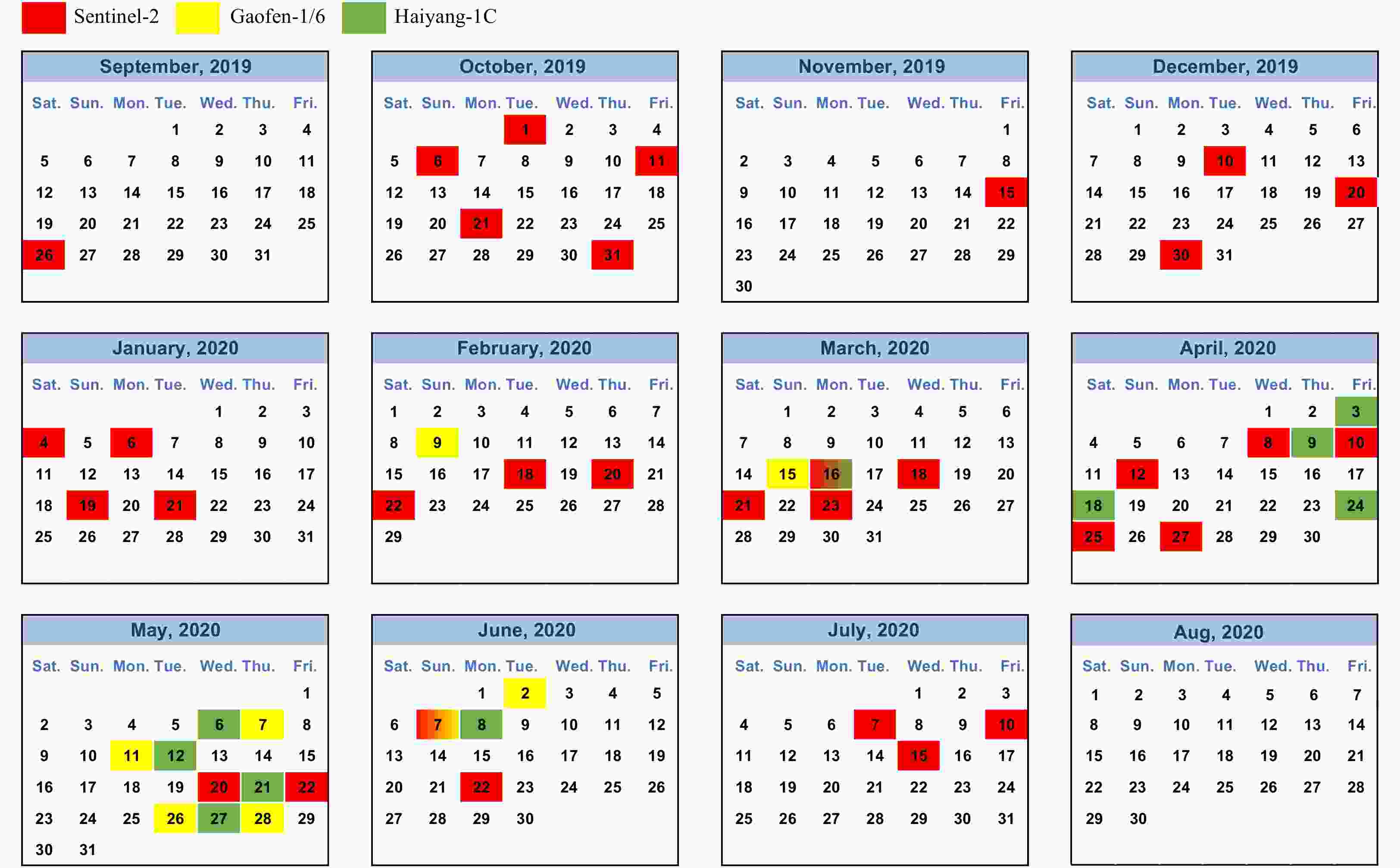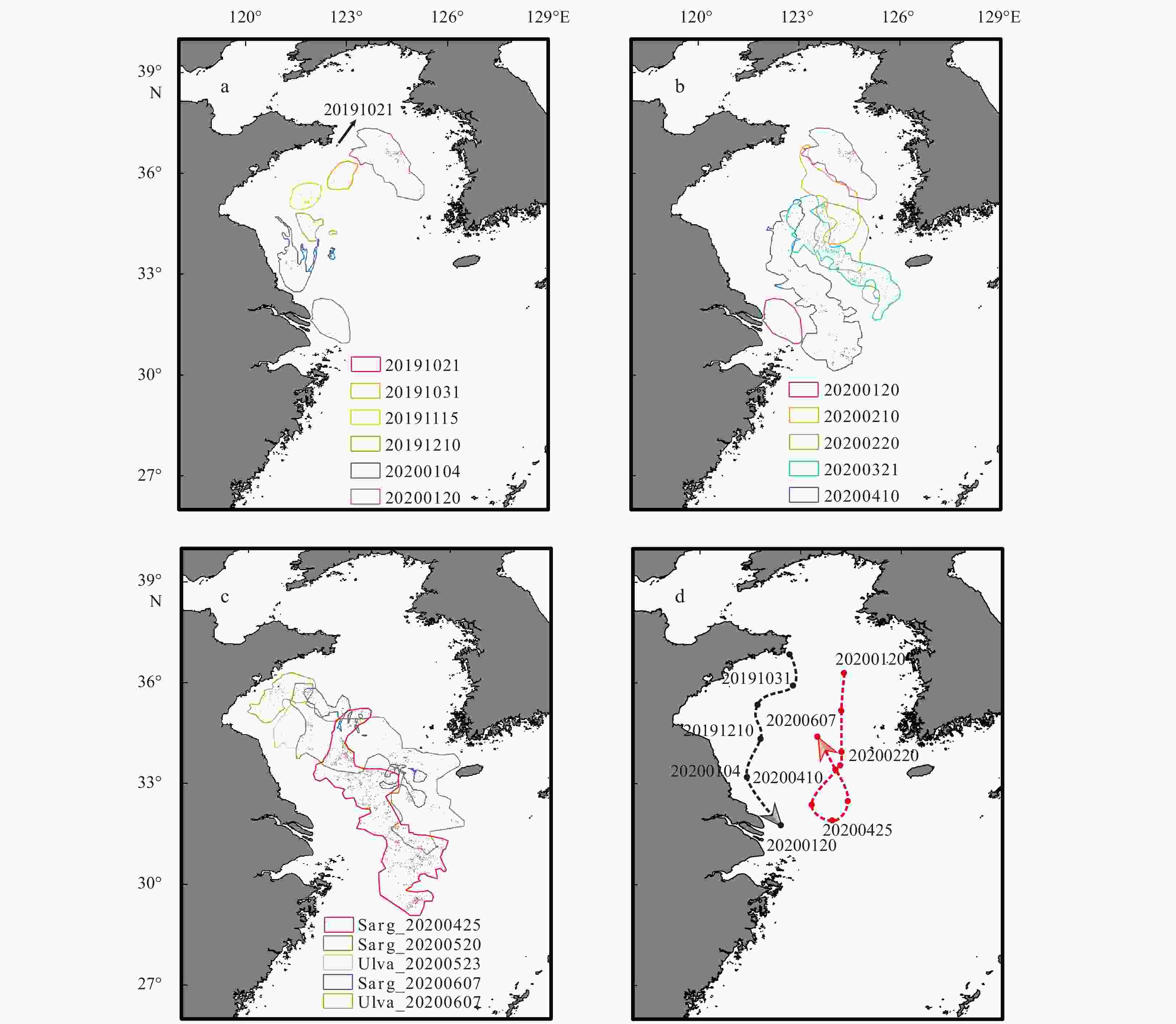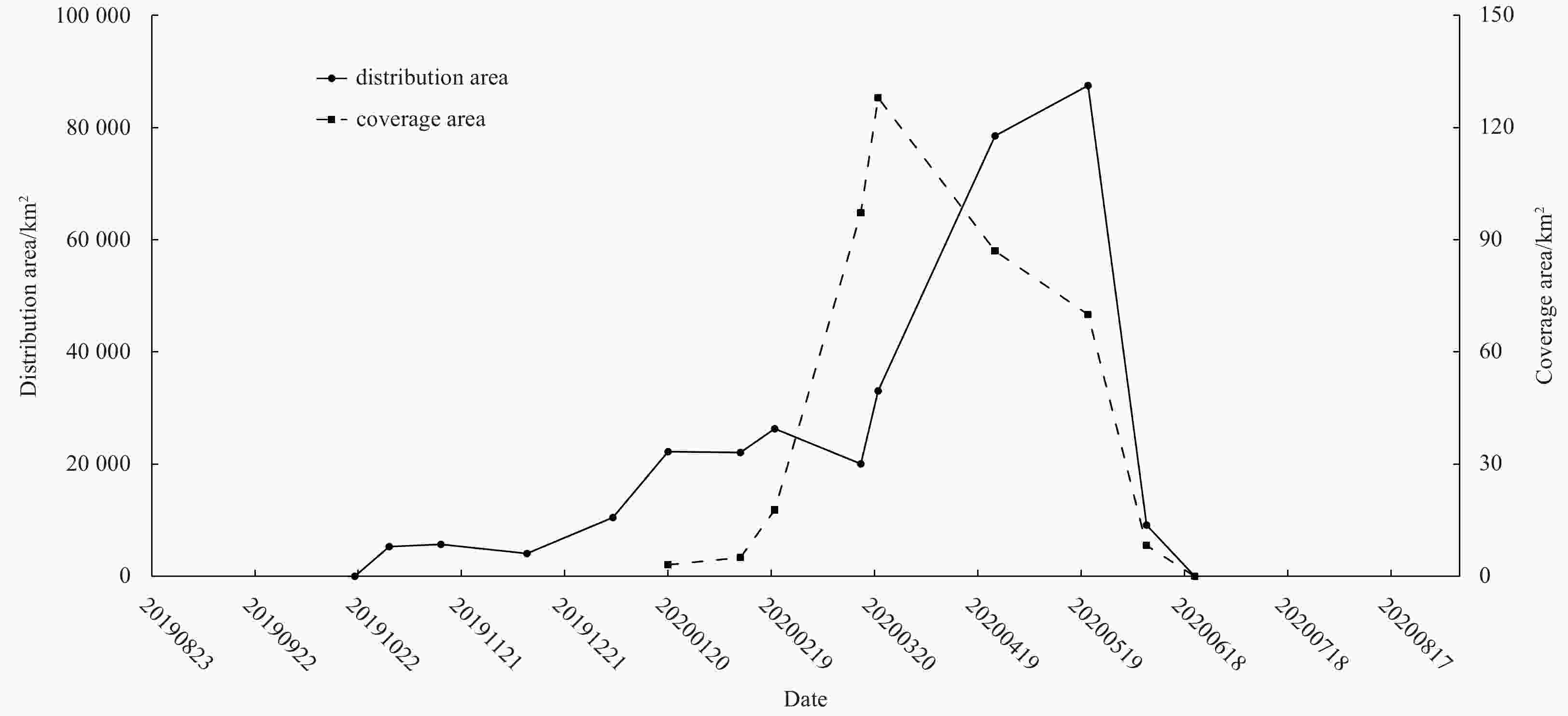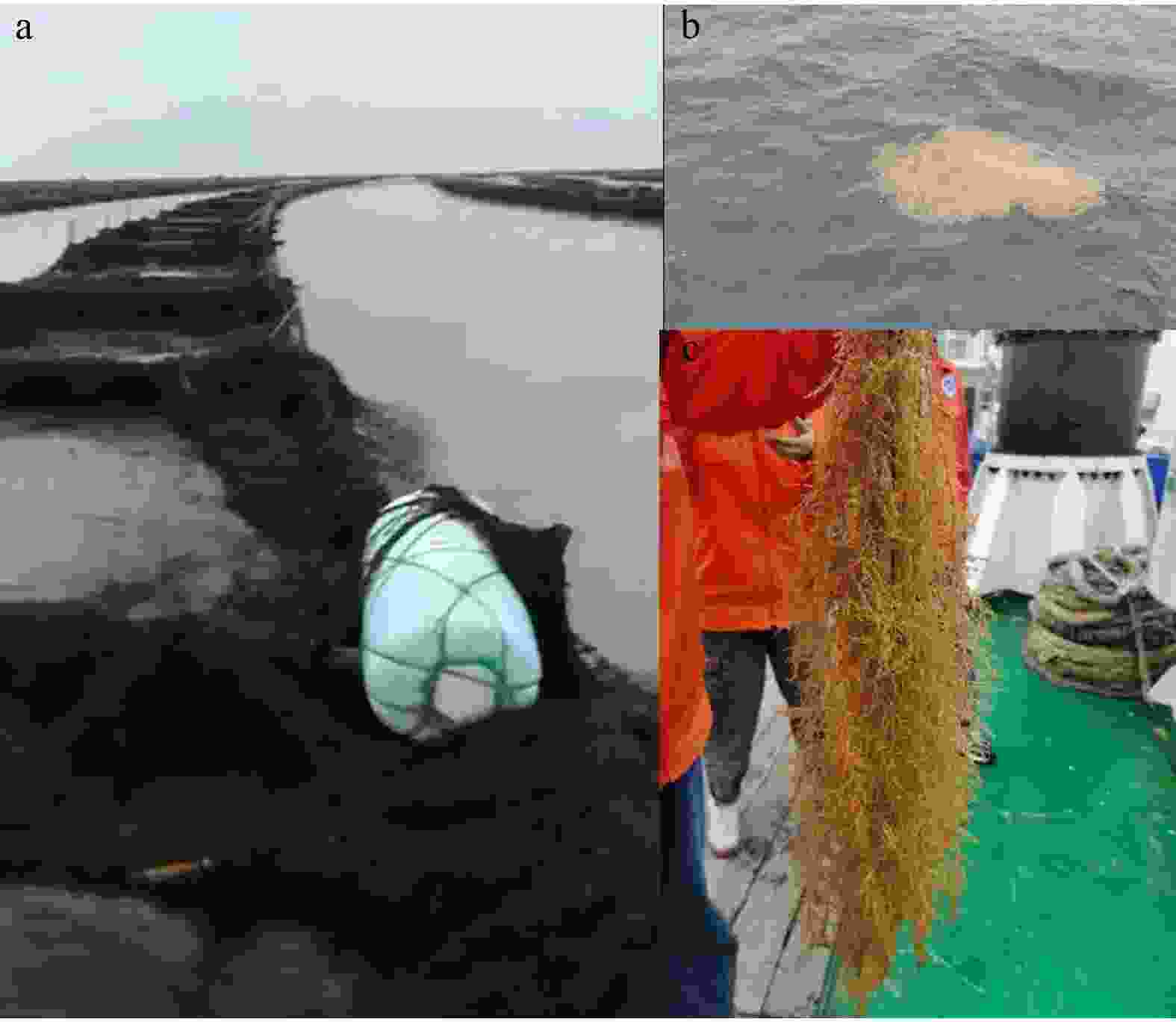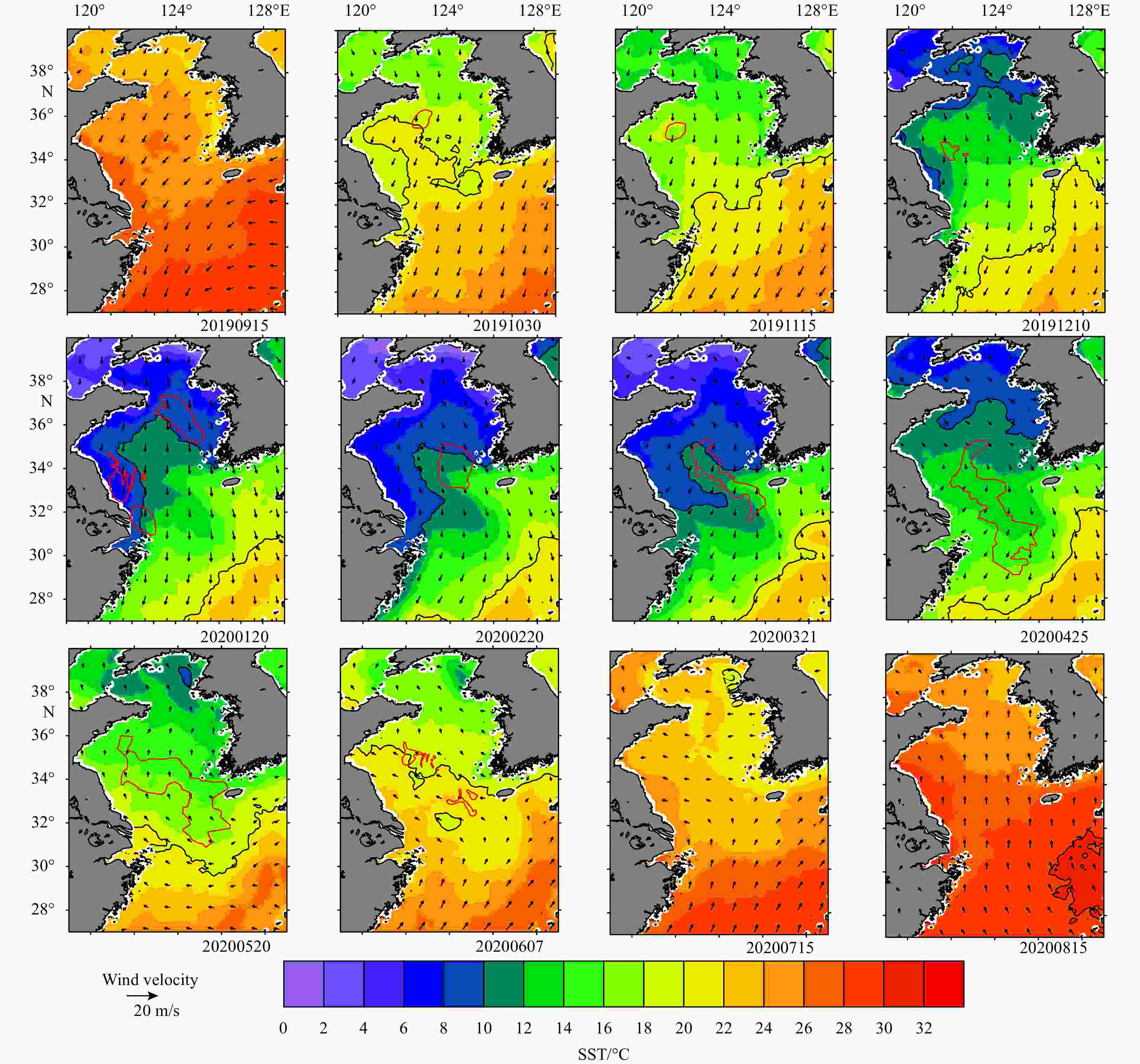Two drifting paths of Sargassum bloom in the Yellow Sea and East China Sea during 2019−2020
-
Abstract: The macroalgal blooms of floating brown algae Sargassum horneri are increasing in the Yellow Sea and East China Sea during the past few years. However, the annual pattern of Sargassum bloom is not well characterized. To study the developing pattern and explore the impacts from hydro-meteorologic environment, high resolution satellite imageries were used to monitor the distribution, coverage and drifting of the pelagic Sargassum rafts in the Yellow Sea and East China Sea from September 2019 to August 2020. Sargassum blooms were detected from October 2019 to June 2020 and presented two successive drifting paths that both initiated from around 37°N. The first path spanned smaller spatial scale and shorter period, starting with a bloom of 3 km2 distribution area near the eastern tip of Shandong Peninsula in late October 2019 and drifted southwards, hit the Pyropia aquaculture area in early January 2020, then vanished in the northwest of East China Sea (ca. 32°N) around end of January. The second path began with a large distribution area of 23 000 km2 east of 123°E in late January 2020, firstly moved southwards in the central Yellow Sea and northern East China Sea (north of 29°N) till late April, then turned northwards with monsoon wind and vanished from late June to August. The mean sea surface temperature of 8°C to 20°C in the Sargassum bloom areas corresponded to in situ observed temperature range for vegetative growth and floating of S. horneri. There was no observed floating Sargassum blooms during July through September in the Yellow Sea and East China Sea. The results indicate that floating S. horneri is unable to complete life cycle in the Yellow Sea and East China Sea, and provide insights to the future management of Sargassum blooms. Further studies are needed to validate the pattern and source of annual Sargassum bloom in the Yellow Sea and East China Sea.
-
Figure 1. The bi-macroalgal bloom in the Yellow Sea on June 7, 2020. a. Area covered by the satellite image analysis in the current study. ★ records natural distribution of benthic Sargassum horneri in Chinese and Korean waters (Tseng, 1983; Hu et al., 2011; Byeon et al., 2019), □ denotes location of panels b and c; b and c are RED-GREEN-BLUE and NIR-RED-GREEN images from Sentinel-2 satellite; d and e, field validation of green tide caused by Ulva prolifera and bloom caused by Sargassum horneri from June 7 to 10, 2020, respectively; f and g, reflectance spectrum of Ulva prolifera and Sargassum horneri from Sentinel-2 MultiSpectral Instrument (solid line with dots) and laboratory measurements (dashed line).
Figure 3. The distribution area of floating Sargassum from October 2019 to January 2020 (a), from January 2020 to April 2020 (b) and from April 2020 to June 2020 (c); two drifting paths of floating Sargassum in the Yellow Sea and East China Sea (d). The distribution area on October 21, 2019 is indicated by black arrow in a. Red and black dots indicate the centroids of distribution area on each date (in YYYYMMDD format). The distribution of green tide caused by Ulva prolifera was also included in c.
Figure 6. Distributions of sea surface temperature (contour) and monthly averaged wind field (vectors) in the Yellow Sea and East China Sea from September 2019 to August 2020. The black contour lines indicate 20°C isotherm from 20191030 to 20200607. The distribution of floating Sargassum is overlaid in red polygons for each month (in YYYYMMDD format).
Table 1. Sensor characteristics of Sentinel-2, Gaofen-1/6 and Haiyang 1C
Satellite sensor Sentinel-2 multispectral instrument Gaofen-1/6 Wide-Field-View Haiyang 1C Coastal Zone Imager Blue-Green-Red-Near Infrared Band 2-3-4-8 1-2-3-4 1-2-3-4 Resolution/m 10 16 50 Swath/km 290 800 950 Revisit cycle/d 5 4 3 Data provider European Space Agency China Centre for Resources Satellite Data and Application China National Satellite Ocean Application Service -
[1] Brooks M T, Coles V J, Hood R R, et al. 2018. Factors controlling the seasonal distribution of pelagic Sargassum. Marine Ecology Progress Series, 599: 1–18. doi: 10.3354/meps12646 [2] Byeon S Y, Oh H J, Kim S, et al. 2019. The origin and population genetic structure of the ‘golden tide’ seaweeds, Sargassum horneri, in Korean waters. Scientific Reports, 9(1): 7757. doi: 10.1038/s41598-019-44170-x [3] Choi H G, Lee K H, Yoo H I, et al. 2007. Physiological differences in the growth of Sargassum horneri between the germling and adult stages. In: Borowitzka M A, Critchley A T, Kraan S, et al., eds. Nineteenth International Seaweed Symposium. Dordrecht: Springer, 279–285 [4] Choi S K, Oh H J, Yun S H, et al. 2020. Population dynamics of the ‘golden tides’ seaweed, Sargassum horneri, on the Southwestern Coast of Korea: the extent and formation of golden tides. Sustainability, 12(7): 2903. doi: 10.3390/su12072903 [5] Cui Tingwei, Zhang Jie, Sun Li’e, et al. 2012. Satellite monitoring of massive green macroalgae bloom (GMB): imaging ability comparison of multi-source data and drifting velocity estimation. International Journal of Remote Sensing, 33(17): 5513–5527. doi: 10.1080/01431161.2012.663112 [6] Darling J A, Carlton J T. 2018. A framework for understanding marine cosmopolitanism in the anthropocene. Frontiers in Marine Science, 5: 293. doi: 10.3389/fmars.2018.00293 [7] Fan Shiliang, Fu Mingzhu, Wang Zongling, et al. 2015. Temporal variation of green macroalgal assemblage on Porphyra aquaculture rafts in the Subei Shoal, China. Estuarine, 163: 23–28 [8] Filippi J B, Komatsu T, Tanaka K. 2010. Simulation of drifting seaweeds in East China Sea. Ecological Informatics, 5(1): 67–72. doi: 10.1016/j.ecoinf.2009.08.011 [9] Hu Zimin, Uwai S, Yu Shenhui, et al. 2011. Phylogeographic heterogeneity of the brown macroalga Sargassum horneri (Fucaceae) in the northwestern Pacific in relation to late Pleistocene glaciation and tectonic configurations. Molecular Ecology, 20(18): 3894–3909. doi: 10.1111/j.1365-294X.2011.05220.x [10] Komatsu T, Matsunaga D, Mikami A, et al. 2008. Abundance of drifting seaweeds in eastern East China Sea. Journal of Applied Phycology, 20(5): 801–809. doi: 10.1007/s10811-007-9302-4 [11] Komatsu T, Mizuno S, Natheer A, et al. 2014. Unusual distribution of floating seaweeds in the East China Sea in the early spring of 2012. Journal of Applied Phycology, 26(2): 1169–1179. doi: 10.1007/s10811-013-0152-y [12] Komatsu T, Tatsukawa K, Filippi J B, et al. 2007. Distribution of drifting seaweeds in eastern East China Sea. Journal of Marine Systems, 67(3–4): 245–252 [13] Li Jingjing, Liu Zhengyi, Zhong Zhihai, et al. 2020. Limited genetic connectivity among Sargassum horneri (Phaeophyceae) populations in the Chinese Marginal Seas despite their high dispersal capacity. Journal of Phycology, 56(4): 994–1005. doi: 10.1111/jpy.12990 [14] Lin Showe-Mei, Huang Roger, Ogawa H, et al. 2017. Assessment of germling ability of the introduced marine brown alga, Sargassum horneri, in Northern Taiwan. Journal of Applied Phycology, 29(5): 2641–2649. doi: 10.1007/s10811-017-1088-4 [15] Liu Dongyan, Keesing J K, Dong Zhijun, et al. 2010. Recurrence of the world’s largest green-tide in 2009 in Yellow Sea, China: Porphyra yezoensis aquaculture rafts confirmed as nursery for macroalgal blooms. Marine Pollution Bulletin, 60(9): 1423–1432. doi: 10.1016/j.marpolbul.2010.05.015 [16] Liu Dongyan, Keesing J K, He Peimin, et al. 2013. The world’s largest macroalgal bloom in the Yellow Sea, China: formation and implications. Estuarine, 129: 2–10 [17] Liu Feng, Liu Xingfeng, Wang Yu, et al. 2018. Insights on the Sargassum horneri golden tides in the Yellow Sea inferred from morphological and molecular data. Limnology and Oceanography, 63(4): 1762–1773. doi: 10.1002/lno.10806 [18] Liu Jinlin, Xia Jing, Zhuang Minmin, et al. 2021. Golden seaweed tides accumulated in Pyropia aquaculture areas are becoming a normal phenomenon in the Yellow Sea of China. Science of the Total Environment, 774: 145726. doi: 10.1016/j.scitotenv.2021.145726 [19] Marks L, Salinas-Ruiz P, Reed D, et al. 2015. Range expansion of a non-native, invasive macroalga Sargassum horneri (Turner) C. Agardh, 1820 in the eastern Pacific. BioInvasions Records, 4(4): 243–248. doi: 10.3391/bir.2015.4.4.02 [20] Masaki H. 2007. Settlement of germlings in some Japanese sargassaceae. Sessile Organisms, 24(2): 89–94. doi: 10.4282/sosj.24.89 [21] Mikani A, Komatsu T, Aoki M, et al. 2006. Seasonal changes in growth and photosynthesis-light curves of Sargassum horneri (Fucales, Phaeophyta) in Oura Bay on the Pacific coast of central Honshu, Japan. La Mer, 44(3–4): 109–118 [22] Mizuno S, Ajisaka T, Lahbib S, et al. 2014. Spatial distributions of floating seaweeds in the East China Sea from late winter to early spring. Journal of Applied Phycology, 26(2): 1159–1167. doi: 10.1007/s10811-013-0139-8 [23] Pang Shaojun, Liu Feng, Shan Tifeng, et al. 2009. Cultivation of the brown alga Sargassum horneri: sexual reproduction and seedling production in tank culture under reduced solar irradiance in ambient temperature. Journal of Applied Phycology, 21(4): 413–422. doi: 10.1007/s10811-008-9386-5 [24] Qi Lin, Hu Chuanmin, Wang Mengqiu, et al. 2017. Floating algae blooms in the East China Sea. Geophysical Research Letters, 44(22): 11501–11509. doi: 10.1002/2017GL075525 [25] Smetacek V, Zingone A. 2013. Green and golden seaweed tides on the rise. Nature, 504(7478): 84–88. doi: 10.1038/nature12860 [26] Song Wei, Li Yan, Fang Song, et al. 2015a. Temporal and spatial distributions of green algae micro-propagules in the coastal waters of the Subei Shoal, China. Estuarine, 163: 29–35 [27] Song Wei, Peng Keqin, Xiao Jie, et al. 2015b. Effects of temperature on the germination of green algae micro-propagules in coastal waters of the Subei Shoal, China. Estuarine, 163: 63–68 [28] Su Li, Shan Tifeng, Pang Shaojun, et al. 2018. Analyses of the genetic structure of Sargassum horneri in the Yellow Sea: implications of the temporal and spatial relations among floating and benthic populations. Journal of Applied Phycology, 30(2): 1417–1424. doi: 10.1007/s10811-017-1296-y [29] Sun Jianzhang, Chen Wandong, Zhuang Dinggen, et al. 2008. In situ ecological studies of the subtidal brown alga Sargasssum horneri at Nanji Island of China. South China Fisheries Science (in Chinese), 4(3): 58–63 [30] Tak Y J, Cho Y K, Seo G H, et al. 2016. Evolution of wind-driven flows in the Yellow Sea during winter. Journal of Geophysical Research: Oceans, 121(3): 1970–1983. doi: 10.1002/2016JC011622 [31] Tseng C K. 1983. Common Seaweeds of China. Beijing: Science Press [32] Wang Mengqiu, Hu Chuanmin, Barnes B B, et al. 2019. The great atlantic Sargassum belt. Science, 365(6448): 83–87. doi: 10.1126/science.aaw7912 [33] Wang Mengqiu, Hu Chuanmin, Cannizzaro J, et al. 2018. Remote sensing of Sargassum biomass, nutrients, and pigments. Geophysical Research Letters, 45(22): 12359–12367. doi: 10.1029/2018GL078858 [34] Wang Zongling, Xiao Jie, Fan Shiliang, et al. 2015. Who made the world’s largest green tide in China?—an integrated study on the initiation and early development of the green tide in Yellow Sea. Limnology and Oceanography, 60(4): 1105–1117. doi: 10.1002/lno.10083 [35] Wu Zuli, Chen Liangran, Wang Kai, et al. 2020. Morphological characteristics of vesicle of Sargassum horneri and its relationship to environmental factors in Gouqi Island. Journal of Fisheries of China (in Chinese), 44(5): 793–804 [36] Wu Hailong, Feng Jingchi, Li Xinshu, et al. 2019. Effects of increased CO2 and temperature on the physiological characteristics of the golden tide blooming macroalgae Sargassum horneri in the Yellow Sea, China. Marine Pollution Bulletin, 146: 639–644. doi: 10.1016/j.marpolbul.2019.07.025 [37] Xiao Jie, Fan Shiliang, Wang Zongling, et al. 2020a. Decadal characteristics of the floating Ulva and Sargassum in the Subei Shoal, Yellow Sea. Acta Oceanologica Sinica, 39(10): 1–10. doi: 10.1007/s13131-020-1655-4 [38] Xiao Yanfang, Liu Rongjie, Kim K, et al. 2021a. A random forest-based algorithm to distinguish Ulva prolifera and Sargassum from multispectral satellite images. IEEE Transactions on Geoscience and Remote Sensing, 60: 4201515, doi: 10.1109/TGRS.2021.3071154 [39] Xiao Jie, Wang Zongling, Liu Dongyan, et al. 2021b. Harmful macroalgal blooms (HMBs) in China’s coastal water: green and golden tides. Harmful Algae, 107: 102061. doi: 10.1016/j.hal.2021.102061 [40] Xiao Jie, Wang Zongling, Song Hongjun, et al. 2020b. An anomalous bi-macroalgal bloom caused by Ulva and Sargassum seaweeds during spring to summer of 2017 in the western Yellow Sea, China. Harmful Algae, 93: 101760. doi: 10.1016/j.hal.2020.101760 [41] Xing Qianguo, Guo Ruihong, Wu Lingling, et al. 2017. High-resolution satellite observations of a new hazard of golden tides caused by floating Sargassum in winter in the Yellow Sea. IEEE Geoscience and Remote Sensing Letters, 14(10): 1815–1819. doi: 10.1109/LGRS.2017.2737079 [42] Xing Qianguo, Hu Chuanmin. 2016. Mapping macroalgal blooms in the Yellow Sea and East China Sea using HJ-1 and Landsat data: application of a virtual baseline reflectance height technique. Remote Sensing of Environment, 178: 113–126. doi: 10.1016/j.rse.2016.02.065 [43] Xing Qianguo, Wu Lingling, Tian Liqiao, et al. 2018. Remote sensing of early-stage green tide in the Yellow Sea for floating-macroalgae collecting campaign. Marine Pollution Bulletin, 133: 150–156. doi: 10.1016/j.marpolbul.2018.05.035 [44] Xu Min, Sakamoto S, Komatsu T. 2016. Attachment strength of the subtidal seaweed Sargassum horneri (Turner) C. Agardh varies among development stages and depths. Journal of Applied Phycology, 28(6): 3679–3687. doi: 10.1007/s10811-016-0869-5 [45] Xu Lingling, Wu Dexing, Lin Xiaopei, et al. 2009. The study of the Yellow Sea Warm Current and its seasonal variability. Journal of Hydrodynamics, Ser. B, 21(2): 159–165 [46] Yoshida T. 1963. Studies on the distribution and drift of the floating seaweeds. Bulletin of Tohoku Regional Fisheries Research Laboratory, 23: 141–186 -




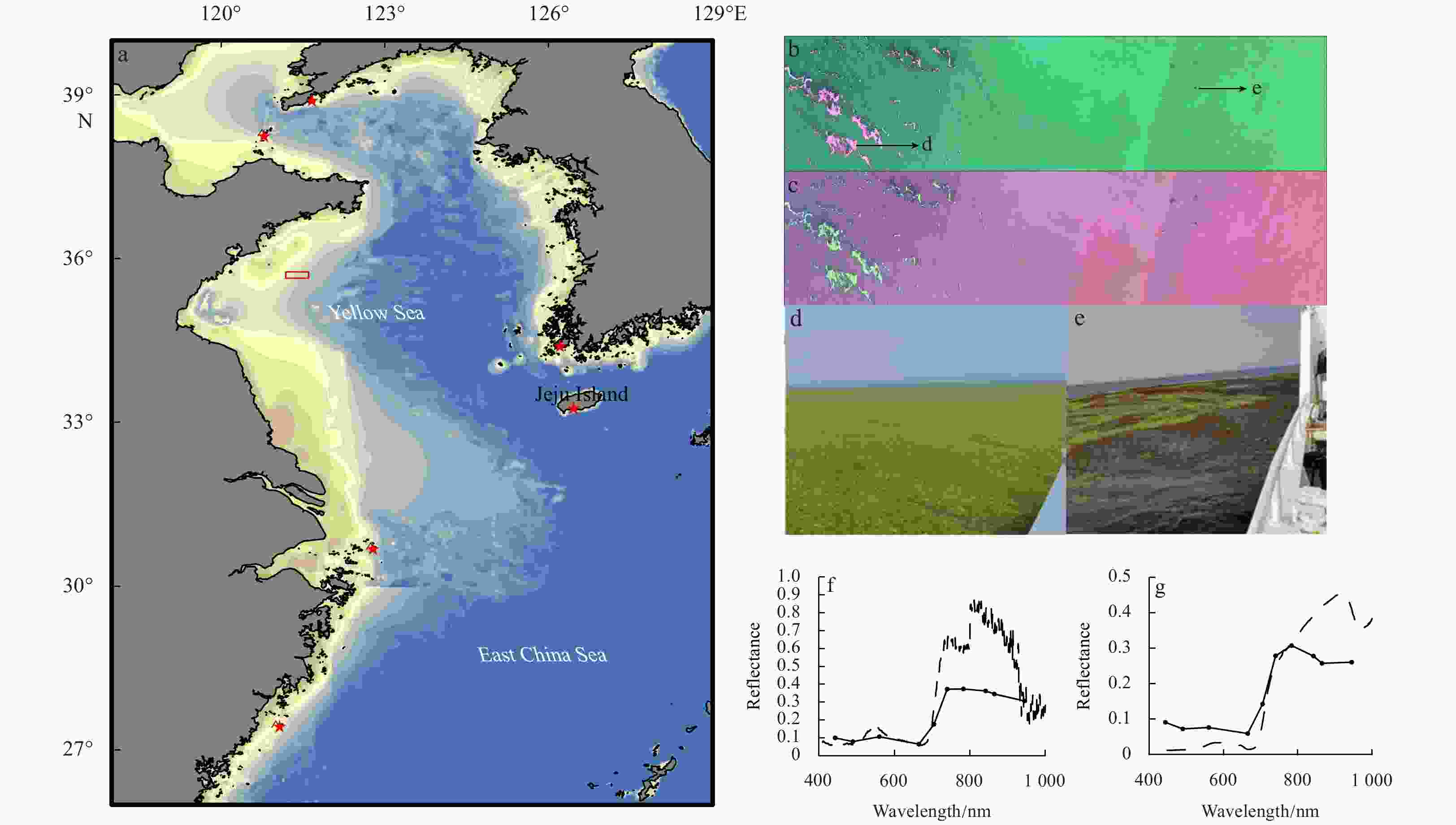
 下载:
下载:
